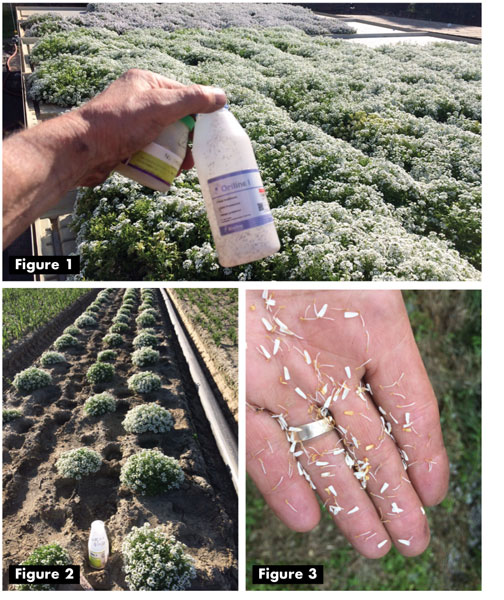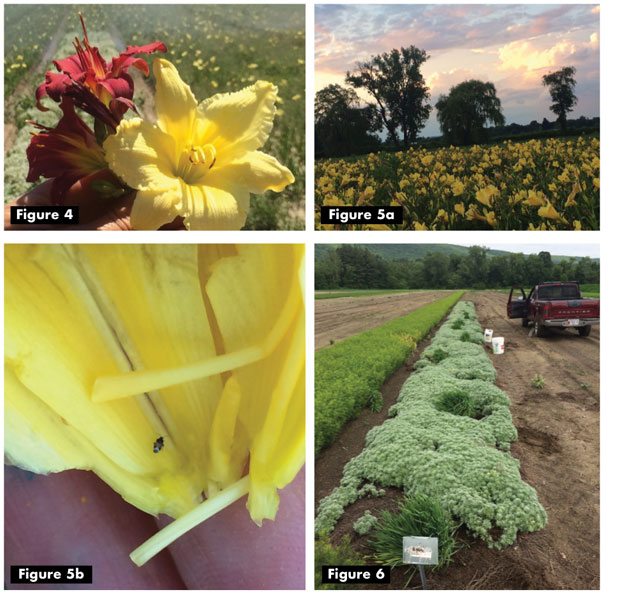11/1/2018
Another Successful Outdoor BCA Season
Roger McGaughey

How did we do it? How do you monitor or quantify success? Can we repeat it again next year?
In last year’s November article, I wrote about how Orius can help with thrips control, so this year, we used what we’d learned and tried to improve on that.
Over the last number of years, we’ve found that peppers didn’t like our herbicide program for weed control, so we decided to simply concentrate on lobularia as our field bankers. One seed variety had been trialed in 2017, so we produced more this year, along with some White Stream, which we produced ourselves from unrooted cuttings. Getting an Orius population established early is critical, so by having some plugs growing under LED lights we were able to achieve an early season introduction.
“How early can we plant out in the field?” was one of our next questions. Last year in our climate, mid-April seemed okay. This year, with nice weather in mid-March, we trialed some plugs in one daylily field. Shortly thereafter it snowed, so that experiment didn’t work.
Figure 1: Orius ready to be sprinkled on lobularia.
Figure 2: Introducing Orius into the field production area.
Figure 3: Hedgerow scouting finds some Orius still present.
We do, however, have the benefit of mobile rollout tables, so we were able to take advantage of outside conditions and get the plants adjusted to a brighter environment. This system also allowed us to easily bring the plants back inside if the weather was unfavorable. Growing outside meant flowering dramatically improved with the higher light levels and we were able to introduce Orius earlier when the outside temperatures were appropriate, e.g., ADTs in the high 60s. Nutrimite was also applied to assist with an extra food source in case there wasn’t enough pollen in the lobularia flowers (Figure 1).
When we started our field daylily planting, we interspersed the plantings with batches of the outside-grown lobularia (some seed and some cutting varieties) so we could monitor their progress throughout the season. Because we treat all of our plants with RootShield Plus prior to planting (the daylilies get dipped in a solution of this material), we expected and got a quick take-off after planting. The lobularia had their treatment under our RootShield boom in the propagation department.
As the lobularia developed and filled out, we made a few Orius introductions with the aim of increasing the initial table population. Introductions should take place in the early morning or later in the day when the sun goes down. We keep ongoing photographic records of the introductions and plant development so that we won’t forget things when it comes to next year (Figure 2).
June was hot and dry and our new water booms got a good workout trying to keep up with 30-plus acres of bareroot perennial production. Daylily crops were beginning to flower and weekly scouting began to take on even more importance. Regular scouting is vitally important; if you don’t check your crops, you don’t know what’s happening.
 I sometimes think back to how lucky I was to be involved with Royal Heins in the early ’90s when he was developing the crop graphical tracking procedure. One of the most important aspects of that was it really forced the growers to get into their crops and take a look and read their plants. The plants are talking to you every day, so go visit and listen to what they’re telling you.
I sometimes think back to how lucky I was to be involved with Royal Heins in the early ’90s when he was developing the crop graphical tracking procedure. One of the most important aspects of that was it really forced the growers to get into their crops and take a look and read their plants. The plants are talking to you every day, so go visit and listen to what they’re telling you.
While driving between some of our fields in early July, I stopped to check out the native flowering shrubs in some of the hedgerows. It was a pleasant surprise to knock Orius out of some of the flowers (Figure 3). These were either natural Orius or some of the population that we’d introduced earlier in the season. Wherever they came from, they were definitely there and it’s really fun to find Orius in the flowers of our thrips-free daylily crop. (Some of the clean flowers can be seen in Figure 4.)
Figure 4: Clean, thrips-free daylily flowers.
Figures 5a & 5b: Scouting at sunset (left) and an Orius in a thrips-free daylily.
Figure 6: Artemisia as banker plants for Aphidius.
We’re exploring the possibility of creating a population of plant material around our property that will provide an early and continuous supply of flowers throughout the season to help in the establishment and survival of beneficial insects. So far, potential lack of water is the real issue with that. However, at this time, I want to thank Leanne Pundt for suggesting websites and other extension services that offer valuable information about plant material that can be used for establishing beneficial insect populations. Utah State Extension Service has produced an extremely good fact sheet on Orius and plants that can provide a habitat for it: utahpests.usu.edu/files/MPB-Factsheet.pdf.
Orius, aka Minute Pirate Bugs, live on a large diet of thrips—about 70 to 80 a day. Thrips are often more active in the evening, so that’s a good time to scout. It’s a wonderful way to end the day, scouting a field at sunset and finding flowers with a good Orius population looking for their evening meal. (Figure 5b shows one of the Orius found in the stand of clean flowers.)
How successful have we been this season? No chemical applications for thrips have been made and our crops are almost entirely thrips-free. It’s been a great Orius year.
Not having to spray insecticides to control thrips is huge. Unfortunately, we weren’t totally chemical-free with respect to aphids. Early in the season, Ron Valentin from Bioline suggested trying a different type of aphid banker plant. Some European information suggested that artemisia showed promise as a habitat for Aphidius. It just so happened that we had a small batch of artemisia from last year still in the ground and developing a good groundcover canopy.
I tried getting a quantity of cereal banker plants with an additional population of Aphidius to become established, but they didn’t like overhead watering, so we’ll have to think again on that one (Figure 6.) Even though some natural Aphidius and other beneficial insects were found on scouting trips, there weren’t enough to take care of a late infestation of red aphids that appeared in one of our crops. We did have to spray to control those pests, but that was the only chemical spray applied all season long.
Over the last number of years, there’s been a lot of work done on trying to learn more about how natural enemy populations can control our pest problems. Whatever information is available, it’s up to the individual grower to try new things, work hard, be observant and figure out what will work for their own particular crop situation.
Leanne also mentioned a new pheromone lure, PredaLure, which attracts beneficial insects into crops to feed on destructive insect pests. It attracts lacewings, lady beetles, syrphids, Orius and Phytoseiulus. We’ll be sure to try some of those in next year’s crops.
Helping to minimize our reliability on chemical control methods is a win-win situation for all concerned. We’ll use the knowledge we’ve learned this year to plan for an even better 2019 season. GT
Roger McGaughey, head grower at Pioneer Gardens in Deerfield, Massachusetts, was educated in Northern Ireland and England and has 44 years experience as a grower.